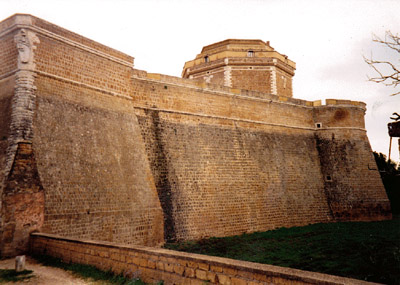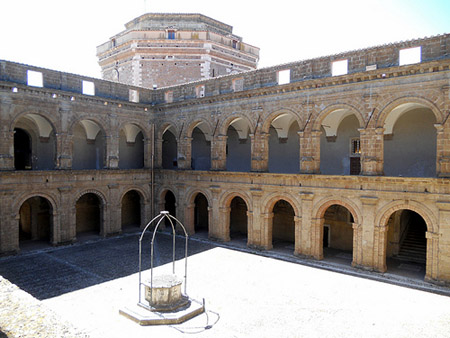 |
Forte Sangallo
Civita Castellana, Italy
|
|
 |
Constructed: 1499 - 1503
Used by: Italy
Conflicts in which it participated:
None
|
The dogged determination to cling to the cylindrical battlements of a bygone era and a big, pointy leading edge, almost like a dagger to be thrust into the breast of an attacker (who would be considerate enough to impale himself on that one big pointy leading edge): The hallmarks of the early starfort!
It might shock present-day Popewatchers to learn that the Pope wasn't always a benign, wrinkly oldster who may or may not have done something slightly distasteful during the Second World War (1939-1945).
|
 |
|
|
Pope Alexander VI (1431-1503) may not have been the worst Pope in history, but his regin was known for "libertinism" (sex) and nepotism. The Pope was a product of the Borgia family, a group of particularly ruthless powermongers who were a major force in Italy of the 15th and 16th centuries. Historian Felix Gilbert (1904-1991) described the situation thusly: "In Italy for thirty years under the Borgias they had warfare, terror, murder and bloodshed, but they produced Michelangelo, Leonardo da Vinci and the Renaissance."
|

A photo, circa 1995, of the Forte's western curtain wall, looking south. Thanks to Peter Presford for the fabbo picture! |
 |
The Borgias also produced a bunch of starforts! In the interest of solidifying the Borgias' territorial gains, Pope Alexander VI arranged to have a series of forts in the early Trace Italienne (starfort) style constructed around central Italy. It was in fact such events as the Borgias' earthly desires that brought starforts into being! Had everything in Italy and the rest of Europe been all peaceful and hunky-dory in this timeframe, everyone might have been perfectly content with the starfort's predecessors, such as ring forts and (ecch) castles.
The Pope enlisted the expertise of Antonio da Sangallo the Elder (1455-1534) for the majority of his starfort needs. |
|
Sangallo is in fact one of the earliest practitioners of the Trace Italienne, having learned his trade by working on some of the very first examples of the starfort, such as the Fortezza di Sarzana. Sangallo built and/or modernized many a fort for the Bogias, including the modernization of the Castel Sant'Angelo in Rome, a very big deal indeed. The location at which Forte Sangallo was built had previously had a medieval fortification perched thereon. The Treja River splits into a messy amalgamation of other little riverlets at this spot, making it an obvious strategic location, but revealing the names of minor rivers is something at which Google Maps does not excel, so you'll pardon my lack of specific river information. Sangallo (or his son, Antonio di Sangallo the Younger (1484-1546), also a fortifications expert; There seems to be some confusion at times regarding which Sangallo did what to which fort) is also responsible for the Fortezza di Sangallo in the port city of Nettuno, to Rome's southwest. Imagine my confusion and eventual consternation when it dawned on me that I was mistakenly researching two different forts with almost the exact same name, age and purpose!
|
Work on the Forte Sangallo about which we're currently talking ceased, unfinished, in 1503 with the death of Pope Alexander VI, but was shortly thereafter completed by Sangallo the Younger. 'Twas used as both an outpost of the northern reaches of the church's territories, and as a Papal residence (for those times when one just has to get away from Rome).
As a crash pad for the Pope, the Forte Sangallo was required to be sumptiously appointed, as no self-respecting Pope is going to sit in a room that is not adorned with a ludicrous amount of gold.
|
 |
 Forte Sangallo's inside. Casemates? Nope, just arches-a-plenty. Forte Sangallo's inside. Casemates? Nope, just arches-a-plenty. |
|
As such, Pope Paul III (1468-1549) and Pope Pius IV (1499-1565) both oversaw extensive interior modifications to Forte Sangallo, which were doubtless appreciated by future Popely inhabitants.
|
A slightly better look at the coat of arms on the Forte's leading edge. |
 |
And then along came Napoleon (1769-1821), either bestowing the benefits of liberty and equality to everything he touched (if you ask a Frenchman), or screwing everything up and needlessly killing endless thousands of people (if you ask anyone else). Napoleon's equality-bestowment in Italy took the form of creating the Kingdom of Italy (of which he graciously crowned himself king) in the north, and the Kingdom of Naples (of which he crowned his brother, Joseph Bonaparte (1768-1844), king) to the south.
Civita Castellana was in the Naples-ish kingdom, and the Forte Sangallo became a prison for Naples-ish purposes. |
|
Unnecessary as a defensive fortification in the middle of a relatively unthreatened land, Forte Sangallo began a period of decline that continued until 1968, when local authorities started wondering, what is that disgusting pile of bricks supposed to be, anyway?! The forte was "radically renovated," and today serves Civita Castellana as a museum of Etruscan art.
The opinions of recent visitors to Forte Sangallo range from gushing about Etrscan art to complaining bitterly about the museum's staff: "If you aren't Italian, or if you don't speak Italian, good luck! You'll need it!"
|
|
|
|
|
|
 |




